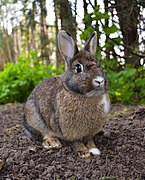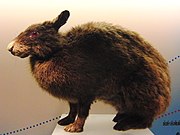List of lagomorphs


Lagomorpha is divided into two
Conventions
Range maps are provided wherever possible; if a range map is not available, a description of the collective range of species in that
Classification

The
Family Leporidae
- Genus Brachylagus (pygmy rabbit): one species
- Genus Bunolagus (riverine rabbit): one species
- Genus Caprolagus (hispid hare): one species
- Genus Lepus(hares): 32 species
- Genus Nesolagus (striped rabbits): two species
- Genus Oryctolagus (European rabbit): one species
- Genus Pentalagus (Amami rabbit): one species
- Genus Poelagus (Bunyoro rabbit): one species
- Genus Pronolagus(red rock hares): four species
- Genus Romerolagus (volcano rabbit): one species
- Genus Sylvilagus(cottontail rabbits): 19 species
Family
- Genus Ochotona(pikas): 29 species
|
Lagomorphs
The following classification is based on the taxonomy described by the reference work Mammal Species of the World (2005), with augmentation by generally accepted proposals made since using molecular phylogenetic analysis, as supported by both the IUCN and the American Society of Mammalogists.[2]
Family Leporidae
Members of the Leporidae family are called leporids, or colloquially rabbits and hares. Leporidae comprises 73 extant species, divided into 11 genera.
| Name | Authority and species | Range | Size and ecology |
|---|---|---|---|
| Brachylagus | Miller, 1900
One species
|
Western America (introduced in red)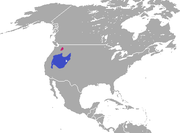
|
Size: 23–30 cm (9–12 in) long, plus 1–3 cm (0.4–1.2 in) tail[3] Habitats: Shrubland and desert[4] Diet: Sagebrush, as well as grass and other plants[3] |
Bunolagus
|
Thomas, 1929
One species
|
Southern South America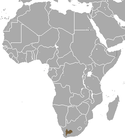
|
Size: 33–47 cm (13–19 in) long, plus 7–11 cm (3–4 in) tail[5] Habitats: Shrubland[6] Diet: Shrubs as well as grass[6] |
Caprolagus
|
Blyth, 1845
One species
|
Himalayas
|
Size: 38–50 cm (15–20 in) long, plus 2–4 cm (1–2 in) tail[7] Habitats: Grassland and inland wetlands[8] Diet: Grass as well as other plants[8] |
Lepus (hare) |
Linnaeus, 1758
32 species
|
Africa, Asia, Europe, and North America | Size range: 28 cm (11 in) long, plus 5 cm (2 in) tail (Yarkand hare) to 76 cm (30 in) long (Desert hare)[9] Habitats: Desert, coastal marine, inland wetlands, forest, shrubland, rocky areas, savanna, caves, and grassland[10] Diets: Wide variety of plants[10] |
| Nesolagus (striped rabbit) |
Major, 1899
Two species
|
Sumatra and the Annamite Range in Laos and Vietnam | Size range: 35 cm (14 in) long (Annamite striped rabbit) to 42 cm (17 in) long plus 17 cm (7 in) tail (Sumatran striped rabbit)[11] Habitats: Forest[12] Diets: Various plants[12] |
| Oryctolagus | Lilljeborg, 1762
One species
|
Europe, southern South America, and Oceana (native in orange, introduced in purple)
|
Size: 38–50 cm (15–20 in) long[13] Habitats: Forest, savanna, shrubland, and grassland[14] Diet: Grass, leaves, buds, bark, and roots[13] |
Pentalagus
|
Lyon, 1904
One species
|
Southern tip of Japan
|
Size: 39–53 cm (15–21 in) long, plus 2–4 cm (1–2 in) tail[15] Habitats: Forest, shrubland, and intertidal marine[16] Diet: Herbs, shrubs, and acorns[16] |
Poelagus
|
St. Leger, 1932
One species
|
Central Africa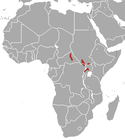
|
Size: 45–50 cm (18–20 in) long, plus 4–5 cm (1.6–2.0 in) tail[17] Habitats: Forest, savanna, and rocky areas[18] Diet: Grass, shrubs, forbs, and tubers[17] |
Pronolagus (red rock hare) |
Lyon, 1904
Four species
|
Southern Africa | Size range: 38 cm (15 in) long, plus 5 cm (2 in) tail (Hewitt's red rock hare) to 56 cm (22 in) long plus 11 cm (4 in) tail (Natal red rock hare)[19] Habitats: Desert, grassland, shrubland, and rocky areas[20] Diets: Grass, herbs, and shrubs[20] |
Romerolagus
|
Merriam, 1896
One species
|
Southern Mexico
|
Size: 27–32 cm (11–13 in) long, plus 1–4 cm (0.4–1.6 in) tail[21] Habitats: Forest and grassland[22] Diet: Grass[21] |
Sylvilagus (cottontail rabbit) |
Gray, 1867
19 species
|
North America and South America | Size range: 21 cm (8 in) long, plus 1 cm (0.4 in) tail (Tres Marias cottontail) to 55 cm (22 in) long plus 8 cm (3 in) tail (Swamp rabbit)[23] Habitats: Desert, inland wetlands, intertidal marine, forest, shrubland, rocky areas, savanna, and grassland[24] Diets: Wide variety of plants[24] |
Family Ochotonidae
Members of the
| Name | Authority and species | Range | Size and ecology |
|---|---|---|---|
Ochotona (pika) |
Link, 1795
29 species
|
Asia and western North America | Size range: 11 cm (4 in) long (Gansu pika) to 29 cm (11 in) long (Northern pika)[25] Habitats: Desert, forest, shrubland, rocky areas, and grassland[26] Diets: Wide variety of plants[26] |
References
- ^ PMID 15503672.
- ^ Wilson, Reeder, pp. 185–211
- ^ a b Rohde, Ashley (2006). "Brachylagus idahoensis". Animal Diversity Web. University of Michigan. Retrieved October 22, 2021.
- .
- ^ Smith, Johnston, Alves, Hackländer, p. 91
- ^ .
- ^ Smith, Johnston, Alves, Hackländer, p. 94
- ^ .
- ^ Lepus sizes:
- Antelope jackrabbit: Smith, Johnston, Alves, Hackländer, p. 160
- Snowshoe hare: Smith, Johnston, Alves, Hackländer, p. 163
- Arctic hare: Smith, Johnston, Alves, Hackländer, p. 166
- Japanese hare: Smith, Johnston, Alves, Hackländer, p. 169
- Black-tailed jackrabbit: Ballenger, Liz (1999). "Lepus californicus". Animal Diversity Web. University of Michigan. Retrieved October 22, 2021.
- White-sided jackrabbit: Dharmani, Aarti (2000). "Lepus callotis". Animal Diversity Web. University of Michigan. Retrieved October 22, 2021.
- Cape hare: Begnoche, Dana (2002). "Lepus capensis". Animal Diversity Web. University of Michigan. Retrieved November 5, 2021.
- Broom hare: Smith, Johnston, Alves, Hackländer, p. 179
- Yunnan hare: Smith, Johnston, Alves, Hackländer, p. 222
- Korean hare: Faigle, Stacy (2014). "Lepus coreanus". Animal Diversity Web. University of Michigan. Retrieved October 22, 2021.
- Corsican hare: Cooper, Thomas (2015). "Lepus corsicanus". Animal Diversity Web. University of Michigan. Retrieved October 22, 2021.
- European hare: Vu, Alan (2001). "Lepus europaeus". Animal Diversity Web. University of Michigan. Retrieved October 22, 2021.
- Ethiopian hare: Smith, Johnston, Alves, Hackländer, p. 190
- Tehuantepec jackrabbit: Warlin, Sierra (2013). "Lepus flavigularis". Animal Diversity Web. University of Michigan. Retrieved October 22, 2021.
- Granada hare: Smith, Johnston, Alves, Hackländer, p. 193
- Abyssinian hare: Nickolai, Ashley (2014). "Lepus habessinicus". Animal Diversity Web. University of Michigan. Retrieved October 22, 2021.
- Hainan hare: Smith, Johnston, Alves, Hackländer, p. 197
- Black jackrabbit: Smith, Johnston, Alves, Hackländer, p. 198
- Manchurian hare: Smith, Johnston, Alves, Hackländer, p. 200
- Indian hare: Lundrigan, Barbara; Foote, Sarah (2003). "Lepus nigricollis". Animal Diversity Web. University of Michigan. Retrieved October 22, 2021.
- Woolly hare: Ng, Jarita (2011). "Lepus oiostolus". Animal Diversity Web. University of Michigan. Retrieved October 22, 2021.
- Alaskan hare: Smith, Johnston, Alves, Hackländer, p. 204
- Burmese hare: Smith, Johnston, Alves, Hackländer, p. 205
- Scrub hare: Kushnereit, Aimee (2004). "Lepus saxatilis". Animal Diversity Web. University of Michigan. Retrieved November 5, 2021.
- Chinese hare: Smith, Johnston, Alves, Hackländer, p. 96
- Ethiopian highland hare: Kingdon, p. 310
- Desert hare: Sullivan, Shaunna (2013). "Lepus tibetanus". Animal Diversity Web. University of Michigan. Retrieved October 22, 2021.
- Mountain hare: Smith, Johnston, Alves, Hackländer, pp. 212–213
- Tolai hare: Smith, Xie, et al., p. 291
- White-tailed jackrabbit: Verts, Carraway, p. 142
- African savanna hare: Riegler, Donald (2013). "Lepus microtis". Animal Diversity Web. University of Michigan. Retrieved November 5, 2021.
- Yarkand hare: Smith, Xie, et al., p. 292
- ^ a b Lepus habitats and diets:
- Antelope jackrabbit: Lorenzo, C.; Brown, D. E. (2019). "Lepus alleni".
- Snowshoe hare: Mills, L.; Smith, A. T. (2019). "Lepus americanus". .
- Arctic hare: Smith, A. T.; Johnston, C. H. (2019). "Lepus arcticus". .
- Japanese hare: Yamada, F.; Smith, A. T. (2019). "Lepus brachyurus". doi:10.2305/IUCN.UK.2019-1.RLTS.T41275A45186064.en.; Holmberg, Jennifer (2014). "Lepus brachyurus". Animal Diversity Web. University of Michigan. Retrieved November 5, 2021.
- Black-tailed jackrabbit: Brown, D. E.; Lorenzo, C.; Álvarez-Castañeda, S. T. (2019). "Lepus californicus". doi:10.2305/IUCN.UK.2019-1.RLTS.T41276A45186309.en.; Ballenger, Liz (1999). "Lepus californicus". Animal Diversity Web. University of Michigan. Retrieved October 22, 2021.
- White-sided jackrabbit: Brown, D. E.; Smith, A. T. (2019). "Lepus callotis". doi:10.2305/IUCN.UK.2019-2.RLTS.T11792A45177499.en.; Dharmani, Aarti (2000). "Lepus callotis". Animal Diversity Web. University of Michigan. Retrieved October 22, 2021.
- Cape hare: Johnston, C. H.; Robinson, T. J.; Child, M. F.; Relton, C. (2019). "Lepus capensis". .
- Broom hare: Ballesteros, F.; Smith, A. T. (2019). "Lepus castroviejoi". .
- Yunnan hare: Smith, A. T.; Johnston, C. H. (2019). "Lepus comus". , p. 287
- Korean hare: Jo, Y.-S.; Smith, A. T. (2019) [errata version of 2019 assessment]. "Lepus coreanus". doi:10.2305/IUCN.UK.2019-1.RLTS.T41279A161750768.en.; Faigle, Stacy (2014). "Lepus coreanus". Animal Diversity Web. University of Michigan. Retrieved October 22, 2021.
- Corsican hare: Randi, E.; Riga, F. (2019). "Lepus corsicanus". doi:10.2305/IUCN.UK.2019-2.RLTS.T41305A2952954.en.; Cooper, Thomas (2015). "Lepus corsicanus". Animal Diversity Web. University of Michigan. Retrieved October 22, 2021.
- European hare: Hacklander, K.; Schai-Braun, S. (2019). "Lepus europaeus". doi:10.2305/IUCN.UK.2019-1.RLTS.T41280A45187424.en.; Vu, Alan (2001). "Lepus europaeus". Animal Diversity Web. University of Michigan. Retrieved October 22, 2021.
- Ethiopian hare: Johnston, C. H.; Tolesa, Z. (2019). "Lepus fagani". .
- Tehuantepec jackrabbit: Lorenzo, C.; Smith, A. T. (2019). "Lepus flavigularis". doi:10.2305/IUCN.UK.2019-3.RLTS.T11790A45176906.en.; Warlin, Sierra (2013). "Lepus flavigularis". Animal Diversity Web. University of Michigan. Retrieved October 22, 2021.
- Granada hare: Soriguer, R.; Carro, F. (2019). "Lepus granatensis". doi:10.2305/IUCN.UK.2019-1.RLTS.T41306A2953195.en.; Weaver, Derek (2013). "Lepus granatensis". Animal Diversity Web. University of Michigan. Retrieved November 5, 2021.
- Abyssinian hare: Johnston, C. H.; Tolesa, Z. (2019). "Lepus habessinicus". doi:10.2305/IUCN.UK.2019-1.RLTS.T41289A45189637.en.; Nickolai, Ashley (2014). "Lepus habessinicus". Animal Diversity Web. University of Michigan. Retrieved October 22, 2021.
- Hainan hare: Smith, A. T.; Johnston, C. (2016). "Lepus hainanus". doi:10.2305/IUCN.UK.2016-3.RLTS.T11793A45177783.en.; Lundberg, Annette (2013). "Lepus hainanus". Animal Diversity Web. University of Michigan. Retrieved November 5, 2021.
- Black jackrabbit: Lorenzo, C.; Johnston, C. H. (2019). "Lepus insularis". doi:10.2305/IUCN.UK.2019-3.RLTS.T11794A45177986.en.; Mejia, Joseph R. (1999). "Lepus insularis". Animal Diversity Web. University of Michigan. Retrieved October 22, 2021.
- Manchurian hare: Smith, A. T.; Johnston, C. H. (2019). "Lepus mandshuricus". , p. 289
- Indian hare: Nameer, P. O.; Smith, A. T. (2019). "Lepus nigricollis". doi:10.2305/IUCN.UK.2019-1.RLTS.T41282A45188041.en.; Lundrigan, Barbara; Foote, Sarah (2003). "Lepus nigricollis". Animal Diversity Web. University of Michigan. Retrieved October 22, 2021.
- Woolly hare: Smith, A. T.; Johnston, C. H. (2019). "Lepus oiostolus". doi:10.2305/IUCN.UK.2019-1.RLTS.T41283A45188432.en.; Ng, Jarita (2011). "Lepus oiostolus". Animal Diversity Web. University of Michigan. Retrieved October 22, 2021.
- Alaskan hare: Smith, A. T.; Johnston, C. H. (2019). "Lepus othus". .
- Burmese hare: Johnston, C. H.; Smith, A. T. (2019). "Lepus peguensis". .
- Scrub hare: Robinson, T. J.; Child, M. F.; Relton, C.; Johnston, C. H. (2019). "Lepus saxatilis". .
- Chinese hare: Smith, A. T.; Johnston, C. H. (2019). "Lepus sinensis". .
- Ethiopian highland hare: Johnston, C. H.; Tolesa, Z. (2019). "Lepus starcki". .
- Desert hare: Smith, A. T.; Johnston, C. H. (2019). "Lepus tibetanus". doi:10.2305/IUCN.UK.2019-1.RLTS.T41307A45193298.en.; Sullivan, Shaunna (2013). "Lepus tibetanus". Animal Diversity Web. University of Michigan. Retrieved October 22, 2021.
- Mountain hare: Smith, A. T.; Johnston, C. H. (2019). "Lepus timidus". , pp. 212–213
- Tolai hare: Smith, A. T.; Johnston, C. H. (2019). "Lepus tolai". .
- White-tailed jackrabbit: Brown, D. E.; Smith, A. T. (2019). "Lepus townsendii". .
- African savanna hare: Johnston, C. H.; Robinson, T. J.; Relton, C.; Child, M. F.; Smith, A. T. (2019). "Lepus victoriae". .
- Yarkand hare: Smith, A. T.; Johnston, C. H. (2017) [errata version of 2016 assessment]. "Lepus yarkandensis". .
- ^ Nesolagus sizes:
- Sumatran striped rabbit: Smith, Johnston, Alves, Hackländer, p. 96
- Annamite striped rabbit: Hoedl, Amanda (2012). "Nesolagus timminsi". Animal Diversity Web. University of Michigan. Retrieved October 22, 2021.
- ^ a b Nesolagus habitats and diets:
- Sumatran striped rabbit: McCarthy, J.; Holden, J.; Martyr, D.; McCarthy, K. (2019). "Nesolagus netscheri".
- Annamite striped rabbit: Tilker, A.; Timmins, R. J.; Nguyen The Truong, A.; Coudrat, C. N. Z.; Gray, T.; Le Trong Trai, Willcox; D. H. A., Abramov; A. V., Wilkinson; N., Steinmetz; R. (2019). "Nesolagus timminsi". doi:10.2305/IUCN.UK.2019-1.RLTS.T41209A45181925.en.; Hoedl, Amanda (2012). "Nesolagus timminsi". Animal Diversity Web. University of Michigan. Retrieved October 22, 2021.
- ^ a b Tislerics, Ati (2000). "Oryctolagus cuniculus". Animal Diversity Web. University of Michigan. Retrieved October 22, 2021.
- .
- ^ Smith, Johnston, Alves, Hackländer, p. 105
- ^ .
- ^ a b Portman, Charles (2004). "Poelagus marjorita". Animal Diversity Web. University of Michigan. Retrieved October 22, 2021.
- .
- ^ Pronolagus sizes:
- Natal red rock hare: Smith, Johnston, Alves, Hackländer, p. 109
- Jameson's red rock hare: Bartel, Riley (2015). "Pronolagus randensis". Animal Diversity Web. University of Michigan. Retrieved October 22, 2021.
- Smith's red rock hare: Smith, Johnston, Alves, Hackländer, p. 112
- Hewitt's red rock hare: Smith, Johnston, Alves, Hackländer, p. 113
- ^ a b Pronolagus habitats and diets:
- Natal red rock hare: Child, M. F.; Matthee, C. M.; Robinson, T. J. (2019). "Pronolagus crassicaudatus". , p. 109
- Jameson's red rock hare: Child, M. F.; Matthee, C. M.; Robinson, T. J. (2019). "Pronolagus randensis". doi:10.2305/IUCN.UK.2019-1.RLTS.T41294A45190258.en.; Bartel, Riley (2015). "Pronolagus randensis". Animal Diversity Web. University of Michigan. Retrieved October 22, 2021.
- Smith's red rock hare: Child, M. F.; Matthee, C. M.; Robinson, T. J. (2019). "Pronolagus rupestris". doi:10.2305/IUCN.UK.2019-1.RLTS.T41295A45190415.en.; Sekine, Ryo (2000). "Pronolagus rupestris". Animal Diversity Web. University of Michigan. Retrieved November 8, 2021.
- Hewitt's red rock hare: Robinson, T. J.; Child, M. F.; Matthee, C. M. (2019). "Pronolagus saundersiae". , p. 113
- ^ a b Smith, Johnston, Alves, Hackländer, pp. 114–115
- .
- ^ Sylvilagus sizes:
- Andean tapeti: Smith, Johnston, Alves, Hackländer, p. 127
- Common tapeti, Central American tapeti, Santa Marta tapeti: Ruedas, L. A.; Marques, S. S.; French, J. H.; Platt II, R. N.; Salazar-Bravo, J.; Mora, J. M.; Thompson, C. W. (October 22, 2019). "Taxonomy of the Sylvilagus brasiliensis complex in Central and South America (Lagomorpha: Leporidae)".
- Swamp rabbit: Smith, Johnston, Alves, Hackländer, p. 118
- Desert cottontail: Smith, Johnston, Alves, Hackländer, p. 120
- Brush rabbit: Smith, Johnston, Alves, Hackländer, p. 123
- Mexican cottontail: Smith, Johnston, Alves, Hackländer, p. 132
- Dice's cottontail: Smith, Johnston, Alves, Hackländer, p. 136
- Eastern cottontail: Smith, Johnston, Alves, Hackländer, p. 138
- Tres Marias cottontail: Viswanathan, Lata (2000). "Sylvilagus graysoni". Animal Diversity Web. University of Michigan. Retrieved October 22, 2021.
- Davis Mountains cottontail: Diersing, V. E.; Wilson, D. E. (June 17, 2021). "Systematics of the mountain-inhabiting cottontails (Sylvilagus) from southwestern United States and northern Mexico (Mammalia: Lagomorpha: Leporidae)". Proceedings of the Biological Society of Washington. 134 (1): 42–79. S2CID 236295647.
- Omilteme cottontail: Lorenzo, C.; Brown, D. E.; Lanier, H. C. (2019). "Sylvilagus insonus". .
- Mountain cottontail: Feldhamer, Carlyle, Chapman, p. 104
- Appalachian cottontail: Kurta, p. 96
- Marsh rabbit: Thompson, Leah (2008). "Sylvilagus palustris". Animal Diversity Web. University of Michigan. Retrieved October 22, 2021.
- Coastal tapeti: Ruedas, L. A.; Marques, S. S.; French, J. H.; Platt II, R. N.; Salazar-Bravo, J.; Mora, J. M.; Thompson, C. W. (February 9, 2017). "A Prolegomenon to the Systematics of South American Cottontail Rabbits (Mammalia, Lagomorpha Leporidae: Sylvilagus)". Miscellaneous Publications of the Museum of Zoology, University of Michigan. 205. ISSN 0076-8405.
- New England cottontail: Berenson, Tessa (2012). "Sylvilagus transitionalis". Animal Diversity Web. University of Michigan. Retrieved October 22, 2021.
- Venezuelan lowland rabbit: Durant, P.; Guevara, M. A. (March 2001). "A new rabbit species (Sylvilagus, Mammalia: Leporidae) from the lowlands of Venezuela". Revista de Biología Tropical. 49 (1).
- ^ a b Sylvilagus habitats and diets:
- Andean tapeti: Ruedas, L. A.; Smith, A. T. (2020) [errata version of 2019 assessment]. "Sylvilagus andinus".
- Santa Marta tapeti: Ruedas, L. A.; Marques, S. S.; French, J. H.; Platt II, R. N.; Salazar-Bravo, J.; Mora, J. M.; Thompson, C. W. (October 22, 2019). "Taxonomy of the Sylvilagus brasiliensis complex in Central and South America (Lagomorpha: Leporidae)". .
- Swamp rabbit: Lanier, H. C.; Nielsen, C. (2019). "Sylvilagus aquaticus". doi:10.2305/IUCN.UK.2019-1.RLTS.T41296A45190578.en.; Roszko, Annamarie (2007). "Sylvilagus aquaticus". Animal Diversity Web. University of Michigan. Retrieved October 22, 2021.
- Desert cottontail: Smith, A. T.; Brown, D. E. (2019). "Sylvilagus audubonii". .
- Brush rabbit: Kelly, P. A.; Lorenzo, C.; Alvarez-Castaneda, S. T. (2019). "Sylvilagus bachmani". .
- Common tapeti: Ruedas, L. A.; Marques, S. S.; French, J. H.; Platt II, R. N.; Salazar-Bravo, J.; Mora, J. M.; Thompson, C. W. (October 22, 2019). "Taxonomy of the Sylvilagus brasiliensis complex in Central and South America (Lagomorpha: Leporidae)". .
- Mexican cottontail: Lorenzo, C.; Lanier, H. C. (2019). "Sylvilagus cunicularius". , p. 132
- Dice's cottontail: Mora, J. M.; Ruedas, L. and Smith; A. T. (2016). "Sylvilagus dicei". , p. 136
- Eastern cottontail: Nielsen, C.; Lanier, H. C. (2019). "Sylvilagus floridanus". .
- Central American tapeti: Ruedas, L. A.; Marques, S. S.; French, J. H.; Platt II, R. N.; Salazar-Bravo, J.; Mora, J. M.; Thompson, C. W. (October 22, 2019). "Taxonomy of the Sylvilagus brasiliensis complex in Central and South America (Lagomorpha: Leporidae)". .
- Tres Marias cottontail: Lorenzo, C.; Lanier, H. C. (2019). "Sylvilagus graysoni". doi:10.2305/IUCN.UK.2019-3.RLTS.T21206A45180643.en.; Viswanathan, Lata (2000). "Sylvilagus graysoni". Animal Diversity Web. University of Michigan. Retrieved October 22, 2021.
- Davis Mountains cottontail: Ruedas, L. A.; Smith, A. T. (2020) [errata version of 2019 assessment]. "Sylvilagus robustus". .
- Omilteme cottontail: Lorenzo, C.; Brown, D. E.; Lanier, H. C. (2019). "Sylvilagus insonus". .
- Mountain cottontail: Smith, A. T.; Brown, D. E. (2019). "Sylvilagus nuttallii". doi:10.2305/IUCN.UK.2019-1.RLTS.T41300A45192243.en.; "Mountain Cottontail — Sylvilagus nuttallii". Montana Field Guide. Montana Department of Fish, Wildlife and Parks. Retrieved November 8, 2021.
- Appalachian cottontail: Barry, R.; Lanier, H. C. (2019). "Sylvilagus obscurus". .
- Marsh rabbit: McCleery, R.; Lanier, H. C. (2019). "Sylvilagus palustris". doi:10.2305/IUCN.UK.2019-1.RLTS.T41303A45192995.en.; Thompson, Leah (2008). "Sylvilagus palustris". Animal Diversity Web. University of Michigan. Retrieved October 22, 2021.
- Coastal tapeti: Ruedas, L. A.; Marques, S. S.; French, J. H.; Platt II, R. N.; Salazar-Bravo, J.; Mora, J. M.; Thompson, C. W. (February 9, 2017). "A Prolegomenon to the Systematics of South American Cottontail Rabbits (Mammalia, Lagomorpha Leporidae: Sylvilagus)". Miscellaneous Publications of the Museum of Zoology, University of Michigan. 205. ISSN 0076-8405.
- New England cottontail: Litvaitis, J.; Lanier, H. C. (2019). "Sylvilagus transitionalis". doi:10.2305/IUCN.UK.2019-2.RLTS.T21212A45181534.en.; Berenson, Tessa (2012). "Sylvilagus transitionalis". Animal Diversity Web. University of Michigan. Retrieved October 22, 2021.
- Venezuelan lowland rabbit: Johnston, C. H.; Smith, A. T. (2019). "Sylvilagus varynaensis". .
- ^ Ochotona sizes:
- Alpine pika: Smith, Johnston, Alves, Hackländer, p. 31
- Helan Shan pika: Smith, Johnston, Alves, Hackländer, p. 33
- Gansu pika: Smith, Johnston, Alves, Hackländer, p. 35
- Collared pika: Smith, Johnston, Alves, Hackländer, p. 36
- Korean pika: Smith, Johnston, Alves, Hackländer, p. 40
- Plateau pika: Smith, Johnston, Alves, Hackländer, p. 40
- Daurian pika: Ciwko, Erin (2014). "Ochotona dauurica". Animal Diversity Web. University of Michigan. Retrieved October 17, 2021.
- Chinese red pika: Smith, Johnston, Alves, Hackländer, p. 46
- Forrest's pika: Smith, Johnston, Alves, Hackländer, p. 47
- Glover's pika: Smith, Johnston, Alves, Hackländer, pp. 48–49
- Hoffmann's pika: Smith, Johnston, Alves, Hackländer, p. 50
- Northern pika: Smith, Johnston, Alves, Hackländer, pp. 51–52
- Ili pika: Smith, Johnston, Alves, Hackländer, p. 54
- Koslov's pika: Smith, Johnston, Alves, Hackländer, p. 56
- Ladak pika: Smith, Johnston, Alves, Hackländer, pp. 57–58
- Large-eared pika: Jordan, Dana (2005). "Ochotona macrotis". Animal Diversity Web. University of Michigan. Retrieved October 17, 2021.
- Manchurian pika: Smith, Johnston, Alves, Hackländer, pp. 60–61
- Nubra pika: Smith, Johnston, Alves, Hackländer, p. 62
- Kazakh pika: Smith, Johnston, Alves, Hackländer, pp. 63–64
- Pallas's pika: Smith, Johnston, Alves, Hackländer, p. 66
- American pika: Smith, Johnston, Alves, Hackländer, pp. 68–70
- Steppe pika: Smith, Johnston, Alves, Hackländer, p. 73
- Royle's pika: Smith, Johnston, Alves, Hackländer, pp. 75–76
- Afghan pika: Smith, Johnston, Alves, Hackländer, p. 77
- Turkestan red pika: Smith, Johnston, Alves, Hackländer, p. 80
- Tsing-ling pika: Smith, Johnston, Alves, Hackländer, p. 82
- Moupin pika: Smith, Johnston, Alves, Hackländer, p. 83
- Thomas's pika: Smith, Johnston, Alves, Hackländer, p. 84
- Turuchan pika: Smith, Johnston, Alves, Hackländer, p. 86
- ^ a b Ochotona habitats and diets:
- Alpine pika: Smith, A. T.; Cook, J. (2016). "Ochotona alpina".
- Helan Shan pika: Smith, A. T.; Li, W. (2016). "Ochotona argentata". .
- Gansu pika: Smith, A. T.; Liu, S. (2016). "Ochotona cansus". .
- Collared pika: Lanier, H. and Hik; D. (2016). "Ochotona collaris". .
- Korean pika: Smith, A. T.; Jo, Y.-S. (2019) [errata version of 2016 assessment]. "Ochotona coreana". .
- Plateau pika: Smith, A. T. and Liu; S. (2019) [amended version of 2016 assessment]. "Ochotona curzoniae". .
- Daurian pika: Smith, A. T.; Cook, J. (2016). "Ochotona dauurica". doi:10.2305/IUCN.UK.2016-3.RLTS.T41259A45182905.en.; Ciwko, Erin (2014). "Ochotona dauurica". Animal Diversity Web. University of Michigan. Retrieved October 17, 2021.
- Chinese red pika: Smith, A. T.; Lissovsky, A. (2016). "Ochotona erythrotis". .
- Forrest's pika: Smith, A. T.; Liu, S. (2016). "Ochotona forresti". .
- Glover's pika: Smith, A. T.; Liu, S. (2016). "Ochotona gloveri". , pp. 48–49
- Hoffmann's pika: Smith, A. T. and Lissovsky; A. (2016). "Ochotona hoffmanni". , p. 50
- Northern pika: Smith, A. T.; Lissovsky, A. (2016). "Ochotona hyperborea". , pp. 51–52
- Ili pika: Li, W.; Smith, A. T. (2019). "Ochotona iliensis". , p. 54
- Koslov's pika: Li, W.; Smith, A. T. (2019). "Ochotona koslowi". .
- Ladak pika: Smith, A. T.; Li, W. (2016). "Ochotona ladacensis". , pp. 57–58
- Large-eared pika: Smith, A. T.; Lissovsky, A. (2016). "Ochotona macrotis". , p. 59
- Manchurian pika: Smith, A. T.; Lissovsky, A. (2016). "Ochotona mantchurica". , pp. 60–61
- Nubra pika: Smith, A. T.; Li, W. (2016). "Ochotona nubrica". , p. 62
- Kazakh pika: Smith, A. T.; Lissovsky, A. (2016). "Ochotona opaca". , pp. 63–64
- Pallas's pika: Lissovsky, A.; Smith, A. T. (2016). "Ochotona pallasii". doi:10.2305/IUCN.UK.2016-3.RLTS.T99890206A45184094.en.; DeMers, Anna (2007). "Ochotona pallasi". Animal Diversity Web. University of Michigan. Retrieved October 17, 2021.
- American pika: Smith, A. T. and Beever; E. (2016). "Ochotona princeps". , pp. 68–70
- Steppe pika: Smith, A. T.; Lissovsky, A. (2016). "Ochotona pusilla". , p. 73
- Royle's pika: Smith, A. T. and Bhattacharyya; S. (2016). "Ochotona roylei". , pp. 75–76
- Afghan pika: Smith, A. T.; Johnston, C. (2016). "Ochotona rufescens". .
- Turkestan red pika: Smith, A. T.; Lissovsky, A. (2016). "Ochotona rutila". .
- Tsing-ling pika: Smith, A. T. and Lissovsky; A. (2016). "Ochotona syrinx". .
- Moupin pika: Smith, A. T.; Liu, S. (2016). "Ochotona thibetana". .
- Thomas's pika: Smith, A. T.; Liu, S. (2019). "Ochotona thomasi". .
- Turuchan pika: Smith, A. T. and Lissovsky; A. (2016). "Ochotona turuchanensis". .
Sources
- Feldhamer, George A.; Thompson, Bruce Carlyle; Chapman, Joseph A. (2003). Wild Mammals of North America. Johns Hopkins University Press. ISBN 978-0-8018-7416-1.
- Kingdon, Jonathan (2015). The Kingdon Field Guide to African Mammals (Second ed.). ISBN 978-1-4729-2531-2.
- Kurta, Allen (1995). Mammals of the Great Lakes Region. ISBN 978-0-472-06497-7.
- Smith, Andrew T.; Johnston, Charlotte H.; Alves, Paolo C.; Hackländer, Klaus, eds. (2018). Lagomorphs: Pikas, Rabbits, and Hares of the World. ISBN 978-1-4214-2340-1.
- Smith, Andrew T.; Xie, Yan; Hoffmann, Robert S.; Lunde, Darrin; MacKinnon, John; Wilson, Don E.; Wozencraft, W. Chris, eds. (2010). A Guide to the Mammals of China. ISBN 978-1-4008-3411-2.
- Verts, B. J.; Carraway, Leslie N. (1998). Land Mammals of Oregon. ISBN 978-0-520-21199-5.
- Hoffmann, Robert S.; Smith, Andrew T. (2005). ISBN 978-0-8018-8221-0.






